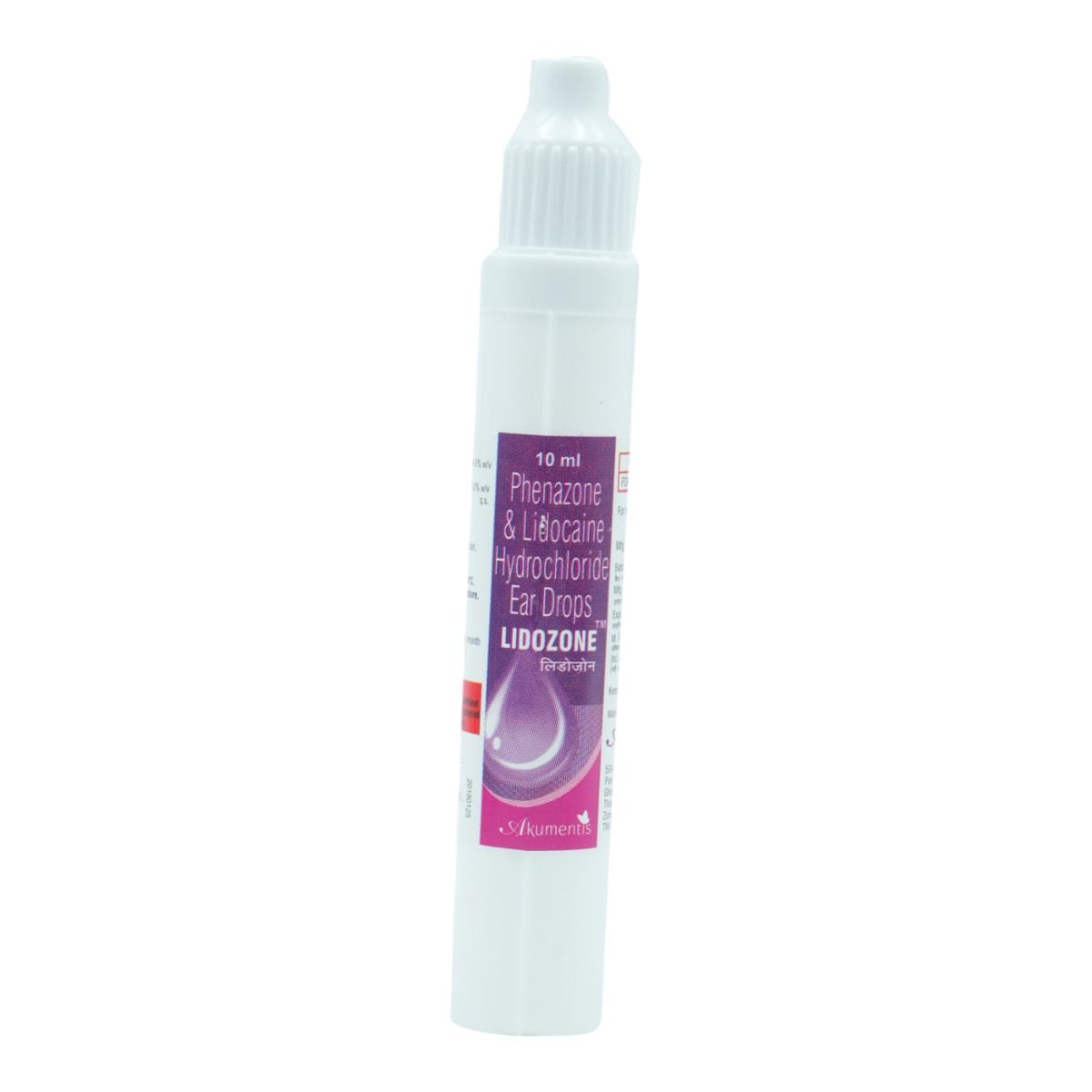Phenazone+lidocaine
About Phenazone+lidocaine
Phenazone+lidocaine belongs to the group of medications called ‘otic agents’ used in the symptomatic treatment of otitis media. Otitis media is the inflammation of the middle ear or middle ear infections. It causes ear pain and fever. It is commonly seen in young children.
Phenazone+lidocaine contains Lidocaine and Phenazone. Lidocaine is a local anesthetic that is used to numb pain. It acts by blocking the pain signals from reaching the brain, thereby decreasing pain. Phenazone is an analgesic (pain killer) and anti-inflammatory agent. It reduces the production of chemical substances that cause pain and inflammation. It also potentiates the action of Lidocaine.
You should use this medicine exactly as prescribed by the doctor. Common side-effects with Phenazone+lidocaine like, local allergic reactions (itching, maculopapular rash), auditory canal hyperaemia (increase of blood flow). However, if you experience any side-effects, inform your doctor immediately.
It is not recommended to use Phenazone+lidocaine if you are allergic to any contents of it. It should not be used in people who have tympanic perforation (perforated or burst eardrum), even if it is due to surgical manipulation. Before using Phenazone+lidocaine, inform your doctor if you are pregnant or breastfeeding. Phenazone+lidocaine should be cautiously used with a doctor's advice in children and elderly people. Phenazone+lidocaine may not interact with alcohol and may not affect your ability to drive; however please seek medical advice.
Uses of Phenazone+lidocaine
Medicinal Benefits
Phenazone+lidocaine is used to reduce ear pain and inflammation in patients with middle ear infections. This medicine is used to treat acute otitis media (inflammation of the middle ear), middle ear inflammation due to flu and barotraumatic damage of the middle ear (due to rapid changes in pressure in the ear). It contains Lidocaine and Phenazone. Lidocaine reduces pain, whereas Phenazone helps to reduce inflammation and also increases the effectiveness of lidocaine.
Directions for Use
Storage
Side Effects of Phenazone+lidocaine
- Local allergic reactions (itching, maculopapular rash)
- Auditory canal hyperaemia (increase of blood flow)
Drug Warnings
Phenazone+lidocaine should not be used in patients with perforated eardrums, even if it is due to surgical manipulation. Symptoms of a perforated eardrum are ear pain, vertigo, ringing or buzzing sensation in the ear, discharge of fluid or blood from the ear, and sudden hearing loss. Your doctor usually checks if the eardrum is intact before prescribing this medicine. While using Phenazone+lidocaine, inform your doctor if you notice any discharge from the ear and stop the medicine immediately. Before using Phenazone+lidocaine, inform your doctor if you are pregnant or breastfeeding. Phenazone+lidocaine should be cautiously used with a doctor's advice in children and elderly people. Phenazone+lidocaine may not interact with alcohol and may not affect your ability to drive; however, please seek medical advice.
Drug Interactions
Drug-Drug Interactions: Inform your doctor if you are using, have recently used or might use any other medicines.
Drug-Food Interactions: No interactions found.
Drug-Disease Interactions: Phenazone+lidocaine should not be used in patients with a perforated eardrum.
Drug-Drug Interactions Checker List:
Safety Advice

Alcohol
safe if prescribedPhenazone+lidocaine may not interact with alcohol.

Pregnancy
cautionPhenazone+lidocaine should be used with caution in pregnant women. So, please consult a doctor before using this medicine.

Breast Feeding
cautionPhenazone+lidocaine should be used with caution in breastfeeding mothers. So, please consult a doctor before using this medicine.

Driving
safe if prescribedPhenazone+lidocaine may not affect your ability to drive.

Liver
safe if prescribedPhenazone+lidocaine is probably safe when used in patients with liver diseases.

Kidney
safe if prescribedPhenazone+lidocaine is probably safe when used in patients with kidney diseases.

Children
cautionPhenazone+lidocaine should be used with caution in infants. In children above 1 year of age, it is probably safe when used if prescribed by a child specialist.
Habit Forming
Diet & Lifestyle Advise
- Manage stress, eat healthily, drink plenty of water, exercise regularly and get plenty of sleep.
- Keep your ear clean and dry.
- Avoid getting water in your ears while bathing, showering or swimming while treating an ear infection.
- Quit smoking.
- Infants should be held in an upright angle while bottle feeding as feeding in the horizontal position may cause the milk to flow back into the eustachian tubes.
- Prevent cold as most ear infections in children begin with a cold.
Special Advise
- Phenazone+lidocaine should be used in the ear only. It should not be used in the eyes or nose.
- Phenazone+lidocaine may cause false-positive results in anti-doping tests, so athletes should use this medicine with caution.
Patients Concern
Disease/Condition Glossary
Otitis media: It is also called a middle ear infection. It occurs when the bacteria or virus enters the ear affecting the middle part of the ear (air-filled space behind the eardrum). It results in inflammation and fluid build-up in the affected area. It can be acute or chronic in nature, varying from short-term to long-term. Symptoms may include ear pain and fever. It is commonly seen in young children with ear tubes.
FAQs
Phenazone+lidocaine is used to treat otitis media (inflammation of the middle ear).
Phenazone+lidocaine contains Lidocaine and Phenazone. Lidocaine is a local anesthetic. It acts by blocking the pain signals from reaching the brain, thereby decreasing pain. Phenazone is an analgesic (pain killer) and anti-inflammatory agent. It reduces the production of chemical substances that cause pain and inflammation. It also increases the effectiveness of Lidocaine.
Phenazone+lidocaine is usually safe and well-tolerated. Phenazone+lidocaine may rarely cause local allergic reactions (itching, maculopapular rash), auditory canal hyperaemia (increase of blood flow).
Phenazone+lidocaine should not be used in patients with a perforated eardrum. It should be used with caution in patients with Glucose-6-phosphate dehydrogenase (G6PD) deficiency as there is a risk of methemoglobinemia (increased hemoglobin levels in the blood that can lead to decreased oxygen levels).
Phenazone+lidocaine is recommended for only ear infections. It should not be used eye or nose. If you are not clear about the use of medicine, please consult your doctor.
Phenazone+lidocaine may usually improve the symptoms within 7 days. However, if the symptoms don’t improve or worsen within 7 days, inform your doctor immediately.
The common causes of ear pain are changes in pressure in the ear, such as when flying on a plane, presence of a foreign object in the ear, ear infections, build-up of earwax, sinus infection, poorly fitting headphones and use of cotton swabs in the ear. There are many causes of ear pain. However, if the ear pain is persistent, consult a doctor to know the exact cause.





